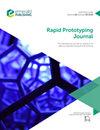通过在预拉伸织物上沉积聚乳酸,直接打印热响应 4D 纺织品
IF 3.6
4区 工程技术
Q1 ENGINEERING, MECHANICAL
引用次数: 0
摘要
目的 本研究旨在利用熔融沉积建模(FDM)三维打印技术开发一种四维(4D)纺织复合材料,该复合材料在热刺激下可自行成型,同时省去了热机械编程步骤,并尝试完善该复合材料的产品开发路径。 设计/方法/途径 利用桌面级 FDM 三维打印技术,将聚乳酸(PLA)打印长丝沉积在预拉伸莱卡针织面料上,构建三层结构的热响应 4D 纺织品。随后,研究了不同聚乳酸厚度和莱卡针织物相对伸长率对热响应 4D 纺织品永久形状的影响。最后,编写了一个仿真程序,并在本研究中通过一个案例演示了如何利用热响应 4D 纺织品和仿真程序设计手腕支撑产品。 研究结果 由聚乳酸和莱卡针织物构成的三层结构在热刺激下可自行成型。该材料还能在一个永久形状和多个临时形状之间实现可逆转换。更薄的聚乳酸沉积层和莱卡针织织物更高的相对伸长率使得热响应 4D 纺织品的永久形状具有更大的弧度。模拟程序准确预测了多种基本形状的永久形态。 原创性/价值 所提出的方法可使 4D 纺织品在受热后直接自成型,有助于提高 4D 纺织品的制造效率。复合材料的热响应性还有助于构建智能的人-材料-环境交互系统。本文章由计算机程序翻译,如有差异,请以英文原文为准。
Direct-print thermally responsive 4D textiles by depositing PLA on prestretched fabrics
Purpose This study aims to develop a four-dimensional (4D) textile composite that self-forms upon thermal stimulation while eliminating thermomechanical programming steps by using fused deposition modeling (FDM) 3D printing technology, and tries to refine the product development path for this composite. Design/methodology/approach Polylactic acid (PLA) printing filaments were deposited on prestretched Lycra-knitted fabric using desktop-level FDM 3D printing technology to construct a three-layer structure of thermally responsive 4D textiles. Subsequently, the effects of different PLA thicknesses and Lycra knit fabric relative elongation on the permanent shape of thermally responsive 4D textiles were studied. Finally, a simulation program was written, and a case in this study demonstrates the usage of thermally responsive 4D textiles and the simulation program to design a wrist support product. Findings The constructed three-layer structure of PLA and Lycra knitted fabric can self-form under thermal stimulation. The material can also achieve reversible transformation between a permanent shape and multiple temporary shapes. Thinner PLA deposition and higher relative elongation of the Lycra-knitted fabric result in the greater curvature of the permanent shape of the thermally responsive 4D textile. The simulation program accurately predicted the permanent form of multiple basic shapes. Originality/value The proposed method enables 4D textiles to directly self-form upon thermal, which helps to improve the manufacturing efficiency of 4D textiles. The thermal responsiveness of the composite also contributes to building an intelligent human–material–environment interaction system.
求助全文
通过发布文献求助,成功后即可免费获取论文全文。
去求助
来源期刊

Rapid Prototyping Journal
工程技术-材料科学:综合
CiteScore
8.30
自引率
10.30%
发文量
137
审稿时长
4.6 months
期刊介绍:
Rapid Prototyping Journal concentrates on development in a manufacturing environment but covers applications in other areas, such as medicine and construction. All papers published in this field are scattered over a wide range of international publications, none of which actually specializes in this particular discipline, this journal is a vital resource for anyone involved in additive manufacturing. It draws together important refereed papers on all aspects of AM from distinguished sources all over the world, to give a truly international perspective on this dynamic and exciting area.
-Benchmarking – certification and qualification in AM-
Mass customisation in AM-
Design for AM-
Materials aspects-
Reviews of processes/applications-
CAD and other software aspects-
Enhancement of existing processes-
Integration with design process-
Management implications-
New AM processes-
Novel applications of AM parts-
AM for tooling-
Medical applications-
Reverse engineering in relation to AM-
Additive & Subtractive hybrid manufacturing-
Industrialisation
 求助内容:
求助内容: 应助结果提醒方式:
应助结果提醒方式:


